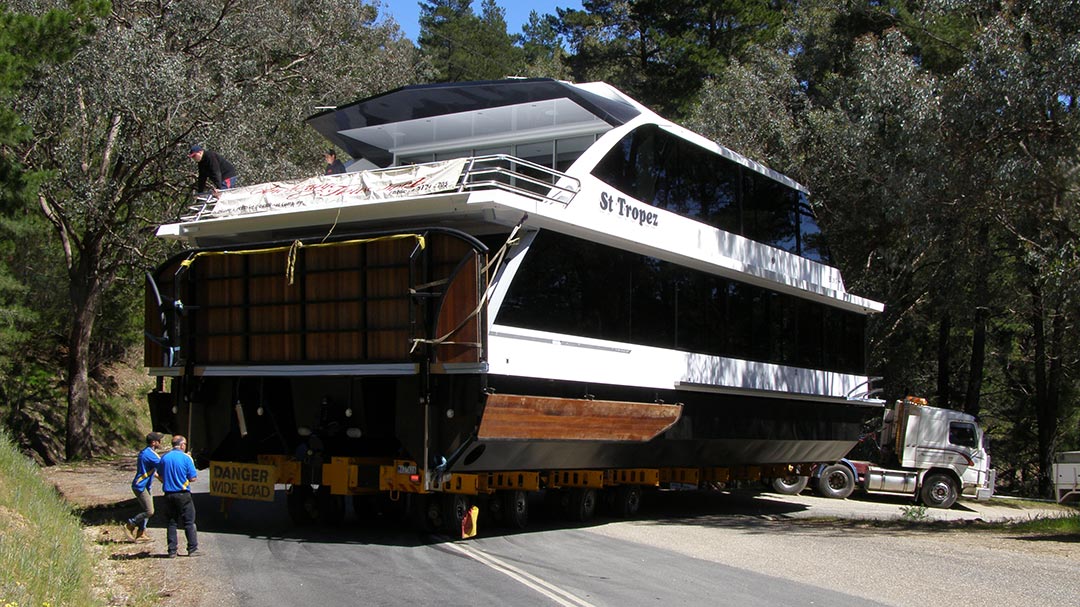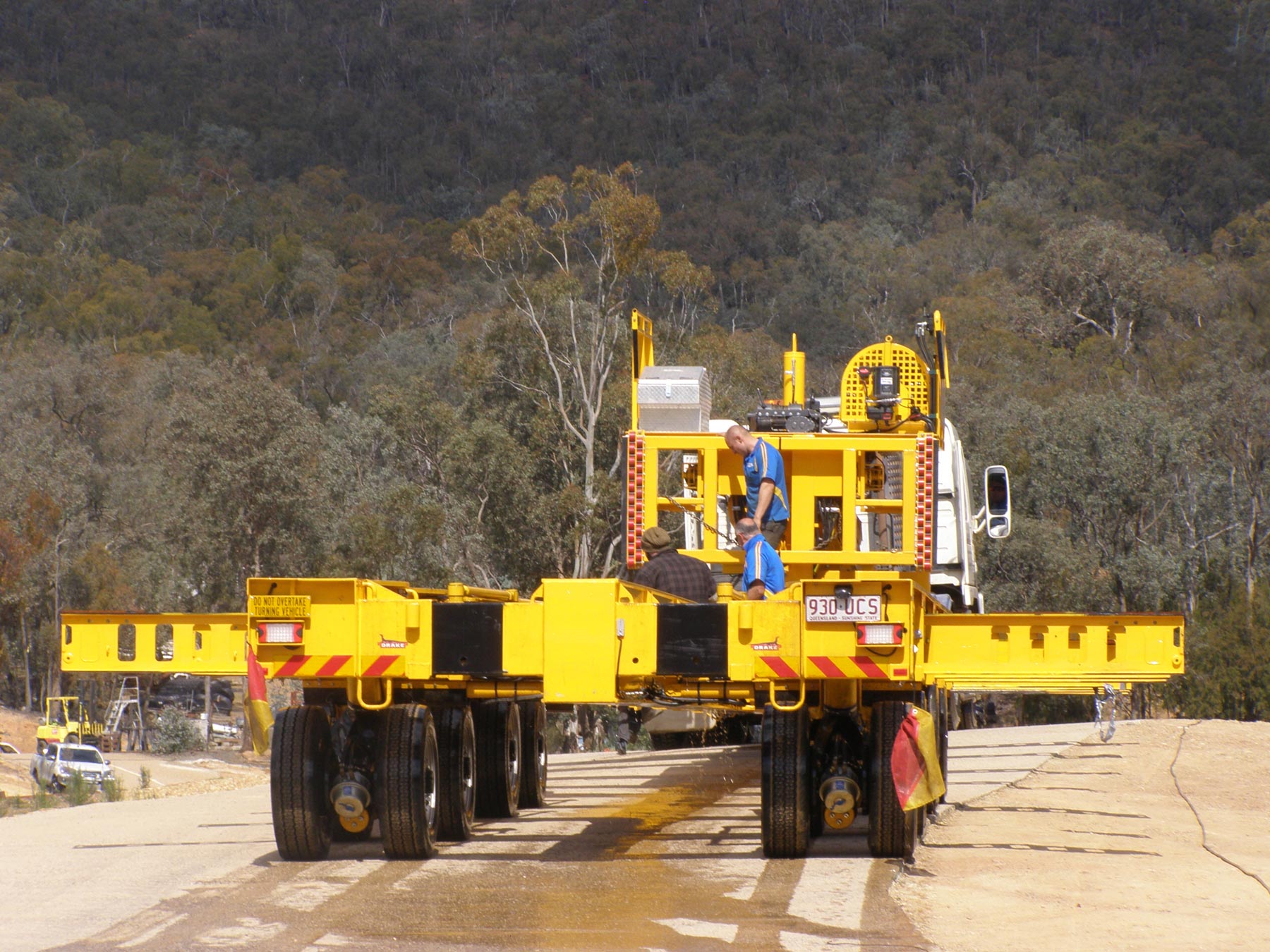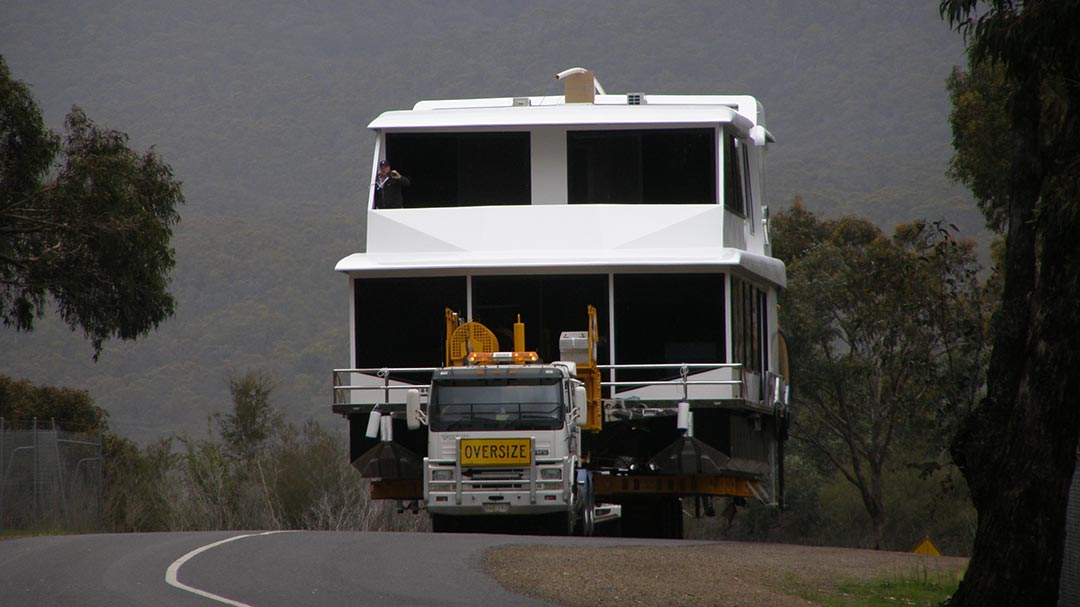A new trailer for extra-large houseboats

- Photos: Mike Dalmau
- Date: 10.09.23
These oversized houseboats, which have become increasingly established on the market since around 2014, are up to three storeys high: they require a floor space of around 7 by 20 metres – as much as ten typical caravans. This placed completely new demands on the trailers that are used to move the houseboats on land: instead of the standard weight of around 40 tonnes, these mobile homes are more likely to weigh between 75 and 80 tonnes. When Phil Dixon and Jeff Thynne, owners of Lake Eildon Marina and Houseboat Hire, realised that their ten-year old trailer earlier was no longer up to the task, they turned to Drake Trailers in Queensland.
Trailer has to perform a number of tasks
“I thought that the company was probably the only manufacturer in Australia capable of producing what we needed,” says Dixon. The trailer has to perform a number of tasks – carrying an 80-tonne load was only the basic requirement. Furthermore, it had to be possible to raise it at the back when it is driven down the slipway – sometimes by up to two metres. It must also be possible to steer a trailer of this type in narrow places, and to do this it is imperative that all axles are movable. And in addition, it must have a length of 20 metres and have arms that can also be extended.
“John Drake, the owner of Drake Trailers, told us that he has never made a trailer such as this in his 50 years of business,” said Dixon. “He personally took care of most of the construction – which we found sensational. He has built something for us that is completely unique in Australia – and probably beyond that.”
Water level on the lake varies strongly
Lake Eildon is a unique home for houseboats, but there is a challenge: at times the shoreline can recede by up to 1.5 kilometres. There are around 750 houseboats on the lake and in several marinas, and this year the water level of the reservoir has fluctuated between 85 and currently 68 per cent of its nominal volume. “When the water level drops, our whole marina moves outwards. Our fuel tap, absolutely everything,” explains Dixon. “Everything has to adapt to the respective water level. Our slipway is two kilometres long, because when the shoreline recedes, the boats move closer together and things generally get tighter.”
At the other extreme, rainwater from the nearby mountains provides a huge influx of water that is sold to farmers further north for irrigation. “When the water starts flowing, it’s like someone has pulled out the plug,” laughs Dixon.
The trailer grows with its duties
Both Phil Dixon and Jeff Thynne own houseboats on the lake and had been holidaying on Lake Eildon for decades when they bought the marina 13 years ago. They now have a plot covering more than 4 hectares around the marina and a winter storage facility of more than 18,000 square metres just five minutes away. “We started small and were completely unknown,” says Dixon. He had worked in the transport industry all his professional life, including some time as a long-distance driver. “And Jeff has a great deal of experience in moving houseboats. So we make a good team. Jeff can move the houseboats anywhere and park them on the trailer in all kinds of conditions.” The mountainous terrain demands a lot of skill from drivers to cope with power lines, heat waves in summer and snow storms in winter. The two take January off, as the marina fills up with tourists.
So Dixon and Thynne knew exactly what they wanted when they asked Drake Trailers for help in transporting the big houseboats. “It was clear to us that if we wanted to set the standard for the next 10 to 15 years, this trailer had to offer something completely new that would not only impress our competitors but completely blow them out of the water.” Sam Drake, Business Development Manager at Drake Trailers, can only agree with this. For him, this trailer has shown the competition that Drake Trailers is able to produce a suitable product line for every sector of industry. He is convinced: “On the basis of this first model, we can now build a variety of different trailers.”
"Real Teamwork"
The design took six months to complete and a further six months to manufacture in Queensland. “We got together with Phil on several occasions and worked out every single detail that was required,” says Drake. “It was real teamwork.” The hydraulic system is an integral part of the design, especially as it has to keep working every day even after being submerged 8 to 10 times – as does the fully steerable trailer. “The axles can not only be raised and lowered, but also individually steered,” explains Drake. “They can be steered either automatically from the truck or via remote control from the support vehicle. This means that Jeff can take over the steering and control the trailer on the roads.”
BPW axles were an obvious choice
The new trailer is equipped with axles from BPW – an obvious choice for Phil Dixon. If you want to build one of the best trailers then naturally you will use the best axles that you can get. If you look at what the axles actually have to do – it’s unbelievable!” The trailers roll out of the depot evening after evening: “And if you look at our previous houseboat trailer with BPW axles and consider all that it’s been through, it’s far more than you could expect.” Some of the new oversized houseboats have a value of more than 3 million Australian dollars. For Phil Dixon and Jeff Thynne, that was another reason to continue taking care of transporting and moving the expensive houseboats themselves – exactly as they had been doing together for years.



